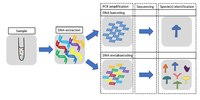
Photo from wikipedia
Introductions of invasive, non-native species in the marine environment are increasing as human activity within coastal areas rises. Genetic datasets are useful tools to identify source populations, track routes of… Click to show full abstract
Introductions of invasive, non-native species in the marine environment are increasing as human activity within coastal areas rises. Genetic datasets are useful tools to identify source populations, track routes of invasions, and illuminate the role of genetic variation in the establishment and subsequent spread of novel introductions. Here, a microsatellite dataset is used to estimate the genetic diversity and population structure of 7 introduced Didemnum vexillum populations in Britain and Ireland, 4 of which are associated with aquaculture and 3 with marinas. Genetic differentiation observed between these populations indicates human-mediated transport as the main mechanism underlying the population structure of D. vexillum in Britain and Ireland. In addition to elucidating patterns of population structure we found that aquaculture sites showed significantly higher genetic diversity (measured as allelic richness) in comparison to the marina sites. We discuss these findings in relation to the history of each invasion, the complex life history of D. vexillum, and available evidence of the relative invasiveness of these populations. Our results show numerous interesting patterns which highlight further research avenues to elucidate the complex factors underlying the global spread of this successful invader.
Journal Title: Biological Invasions
Year Published: 2021
Link to full text (if available)
Share on Social Media: Sign Up to like & get
recommendations!